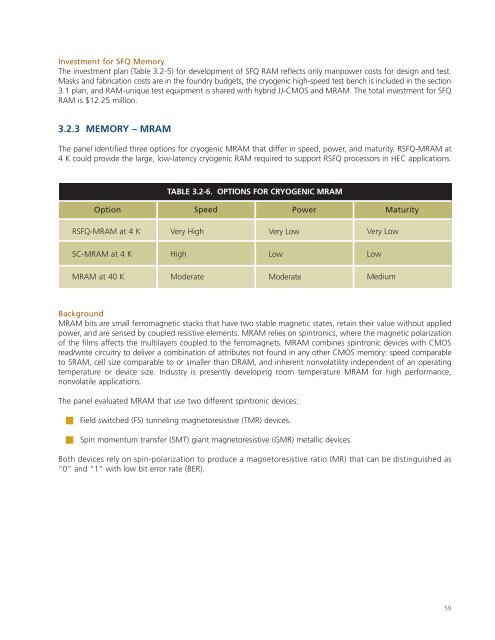Superconducting Technology Assessment - nitrd
Superconducting Technology Assessment - nitrd
Superconducting Technology Assessment - nitrd
Create successful ePaper yourself
Turn your PDF publications into a flip-book with our unique Google optimized e-Paper software.
Investment for SFQ Memory<br />
The investment plan (Table 3.2-5) for development of SFQ RAM reflects only manpower costs for design and test.<br />
Masks and fabrication costs are in the foundry budgets, the cryogenic high-speed test bench is included in the section<br />
3.1 plan, and RAM-unique test equipment is shared with hybrid JJ-CMOS and MRAM. The total investment for SFQ<br />
RAM is $12.25 million.<br />
3.2.3 MEMORY – MRAM<br />
The panel identified three options for cryogenic MRAM that differ in speed, power, and maturity. RSFQ-MRAM at<br />
4 K could provide the large, low-latency cryogenic RAM required to support RSFQ processors in HEC applications.<br />
TABLE 3.2-6. OPTIONS FOR CRYOGENIC MRAM<br />
Option<br />
Speed<br />
Power<br />
Maturity<br />
RSFQ-MRAM at 4 K<br />
Very High<br />
Very Low<br />
Very Low<br />
SC-MRAM at 4 K<br />
High<br />
Low<br />
Low<br />
MRAM at 40 K<br />
Moderate<br />
Moderate<br />
Medium<br />
Background<br />
MRAM bits are small ferromagnetic stacks that have two stable magnetic states, retain their value without applied<br />
power, and are sensed by coupled resistive elements. MRAM relies on spintronics, where the magnetic polarization<br />
of the films affects the multilayers coupled to the ferromagnets. MRAM combines spintronic devices with CMOS<br />
read/write circuitry to deliver a combination of attributes not found in any other CMOS memory: speed comparable<br />
to SRAM, cell size comparable to or smaller than DRAM, and inherent nonvolatility independent of an operating<br />
temperature or device size. Industry is presently developing room temperature MRAM for high performance,<br />
nonvolatile applications.<br />
The panel evaluated MRAM that use two different spintronic devices:<br />
■<br />
■<br />
Field switched (FS) tunneling magnetoresistive (TMR) devices.<br />
Spin momentum transfer (SMT) giant magnetoresistive (GMR) metallic devices.<br />
Both devices rely on spin-polarization to produce a magnetoresistive ratio (MR) that can be distinguished as<br />
“0” and “1” with low bit error rate (BER).<br />
59














